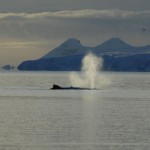These are by far the most rotund and plump whales I have ever been around. When they rise, the span of their backs looks like a small parking lot.
We returned overnight to our home away from home; Wilhelmina Bay. at first light, we were positioned in the southern end of the bay, a cul-de-sac of craggy mountains bridged together by glaciers that seem to wrap themselves around the rock, slowly, dripping into the sea. The sheer sides of the mountains are exposed, but many of the peaks are slathered with thick caps of frosting. The novelties this morning were a high sky free of clouds and only the whisper of a breeze.
We launched the small boats as soon as we could see past our noses. Our hopes for the day were to deploy a DTAG for an overnight track. This would be a companion data set with the other similar track. These overnight tracks are really the backbone of our foraging analyses, especially in the fall season where the days are short. From the echosounder and current data, it has become dogma that the massive krill aggregations in this bay remain deep during the day and occupy the upper 200-300 meters of the water column at night.Why then would a whale make the effort to swim down deep during the short daylight hours to find food, when it will literally rise to the surface at night? It almost feels like we know this predator-prey relationship like a good friend, but it has been just over a week! It is an amazing feeling to be able to sense the rhythms of the ecosystem by spending so much time observing the whales and the prey.
With such flat and calm conditions, the logging humpback whales (and those still meandering around after a night’s feed) were easy targets to spot. We moseyed up to a trio of fully grown whales without incident and had a tag on before 9 am. I have to thank the abundance of krill, and the glutenous feeding rates of the whales for making my job pretty easy. These are by far the most rotund and plump whales I have ever been around. When they rise, the span of their backs looks like a small parking lot. Putting the tag on almost feels like trying to hit a trampoline with a chopstick. We are grateful for the whales being so cooperative to our curiosity.
- whales surfacing in the morning
We made the decision soon thereafter to deploy a second tag on another whale for the daylight hours to increase our sample size for this time period. The whale we approached was so still that we cut our engine off 30 yards from it and simply glided close enough to bejewel the whale with our odd looking pendent.
While the prey mapping zodiac made its rounds of the bay both whales remained lazy and serene. clouds eventually covered the skies, but the seas remained glassy. Among the humpback whales, however, was a new species. We happened across at least 2 southern right whales, acting similarly to the humpbacks (or is it vice versa?). The distinctive calosities on the bonnet of their heads and the lack of a dorsal fin were the keys to distinguishing the two species. These whales breed off the southern coast of Argentina at well known and studied locations.
The day time tag stayed on a bit longer than expected and the zodiacs were forced to use all of their skill to keep tabs on the whale as light faded. With help from the ship’s spotlights, the tag was retrieved without incident and brought back to the ship just before dinner time. as light became dark, the whales started diving deeper and getting into prime feeding mode. We are now set up on the bridge with our antennas pointing all around, listening for those sacred beeps that keep us in touch with the whale. All are hopeful for a calm evening, and if all goes well we will rise with the sun in the morning, locate the whale and wait for the tag to release around 9 am.

